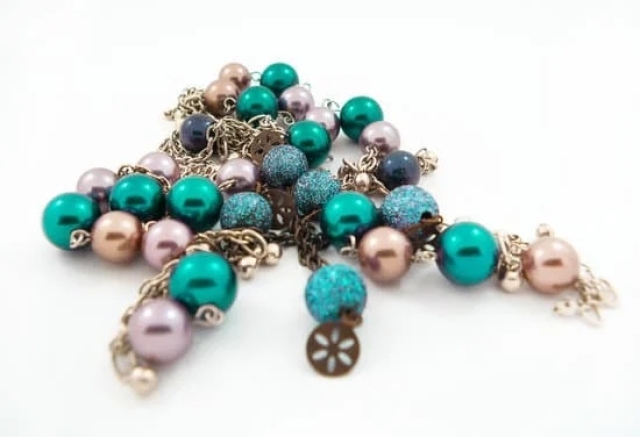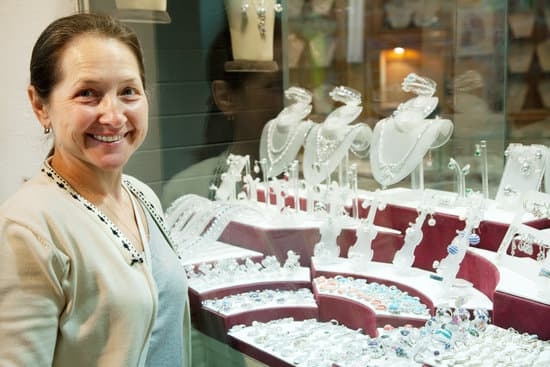The history of art nouveau jewelry began in the mid-1800s when a creative movement sparked a fashion for intricate, delicate jewelry designs. This contemporary movement flourished with the exploration of new styles and unique design elements. During this time, variations on motifs from nature were used to create impressive pieces of jewelry that epitomized the feminine beauty with lavish organic designs and calligraphic flourishes.
Some of the common design elements used during this period included sinuous lines, asymmetrical shapes, flowers, beautiful curves, insects, cascading water, plants and animals. The overall effect was one of dreamy romance with natural elements brought alive in precious metal and gemstones.
Notable Designers of Art Nouveau Jewelry There were many talented jewelers who made significant contributions to the Art Nouveau jewelry movement during this time. One notable designer was Rene Lalique who specialized in using glass to make stunning pieces using vibrant colors and varied textures. His pieces remain highly sought after by collectors today as they show off his signature style including vine leaves dripping crystal dewdrops, expertly realized birds in flight or dragons encircling glittering gemstones.
Julius Rappoport is known for creating stunning high-quality enameled pieces such as portraits rendered against ebullient backgrounds that combine phosphorescent hues with dreamy imagery that evoke an aesthetic not seen before or after his era.
Other popular creators included Emile Galle’s delicate collection of curved organic forms featuring horseshoe crab eyes set into detailed gold work while Carlo Giuliano’s breathtaking jewels feature detailed meticulous detail celestially inspired necklaces, earrings and brooch pins utilizing nature’s most beautiful subjects such as butterflies combined with gems including opals and pearls.
Continued Popularity Today Art Nouveau jewelry is still popular today due to its romantic aesthetic which combines traditional craftsmanship expertly combined with imaginative aesthetics that make them perfect for modern wear or investment purposes. This type of jewelry continues to capture people’s imaginations as these intricate works captivate their senses through masterful designs featuring vibrant colors created from responsibly gathered materials such as precious gems and metals making them timeless treasures widely admired by many generations over time.
History of Art Nouveau Jewelry
Art Nouveau jewelry was a major shift in the way that craftsmen worked, developing from late 19th century and early 20th century design movements. This style was popularized by designers such as Louis Comfort Tiffany in the United States and René Lalique in France.
At its core, Art Nouveau is characterized by a focus on natural forms, abstract shapes, and asymmetrical patterns that were inspired by nature and organic forms. However, this style isn’t just one cohesive movement but instead draws influences from multiple time periods.
Impressionsim
The Impressionsitic period of the late 19th century had a strong influence on Art Nouveau jewelry design. Artists like Monet, Manet, Cezanne, and Pissarro all pushed the boundaries of painting during this time as they experimented with bright colors and dynamic compositions. These effects can also be seen in Art Nouveau pieces which often feature colorful patterns derived from natural forms or otherwise unexpected color combinations.
Symbolism
The Symbolist Movement of Europe at the end of the 1800s had an impact on Art Nouveau jewelry as well. Symbolists used visual representations to convey emotional states or fantastic ideas rather than realistically illustrating their subjects.
This influenced designers like René Lalique who crafted enigmatic objects featuring mysterious designs based on myths and folklore. Even when creating more literal interpretations like his dragonfly motif, he imbued them with a dream-like quality that captured an otherworldly essence suggested by Symbolism.
Japanese Influence
While largely European centric, Art Nouveau also drew inspiration from Japanese art forms; particularly Shishiai-e wood block prints and furniture designs from Heian era Japan were significant sources of creative influence for European designers at the dawning of the 20th century. Designers such as Tiffany adopted stylistic elements such as curved lines, asymmetry, fluidity, minimal details, potential abstracts shapes into their works jewels creating distinctly oriental aesthetics despite being made in Europe.
Origins and Influences Behind Art Nouveau Jewelry
Art Nouveau jewelry is a unique style of design that developed in the late 19th century and combines French, British, Austrian, Dutch and Belgian art with influences from Pre-Raphaelite Art and Japanese art. The style was characterized by its organic lines which evoke whimsical imagery and appealed to both male and females alike due to the abstract beauty it created.
These motifs often depicted nature-inspired elements such as leaves, flowers, vines, animals and other symmetrical designs. One of the most notable artists associated with this movement was René Lalique who in 1872 opened up a successful glassworks studio in Paris.
Nature-Inspired Objects
Due to its emphasis on natural forms such as animals, birds, fish, insects and plants much of Art Nouveau jewelry had a strong connection to the environment that surrounded it. Inspirations drawn from flora were often used as patterns for the pieces which features several pressed diamonds or precious stones within each piece emulating facets seen within nature itself.
Jewelry could also be embellished with pearls making them appear more luxurious or decorated with colorful enameled outlining which hinted at exoticism. This clever combination of materials blended together ultimately gave these pieces something excitingly new crafted in innovative ways that had yet unseen before.
Symmetrical Designs
One major aspect of this particular movement revolved around its use of intricate symmetrical designs which fit their inspiration almost perfectly – capturing those iconic looks seen so often throughout the world of nature but giving them an extra flair due to their proportions being bigger than life hence adding more character out of proportion figures could look beautiful yet surreal all at once.
It was this perfect balance between realism or fantasy that made Art Nouveau jewelry so incredibly desirable over other adornments from previous decades thereby serving as timeless keepsakes for generations to come regardless if they were owned by men or women alike – both genders had something worth treasuring whenever they looked upon these spectacular objects throughout their lives.
Signatures of Art Nouveau Jewelry Design
Art Nouveau jewelry first emerged during the 1890s in Europe as a response to the ornamental motifs of the Victorian era. Demonstrating a break from literal representation, Art Nouveau jewelry was intended to draw its inspiration from natural forms while maintaining an abstracted appeal. Through fluid embraces of organic shapes, subtle curves, and ethereal expressions, this artwork captured the female figure with graceful poise.
Symbols of Nature
The most defining characteristic of Art Nouveau jewelry was the incorporation of decorative motifs depicting nature. These motifs were employed to signal a departure from traditional jewellery practices and to represent a more creative approach to design.
Examples of commonly used designs include dragonflies, butterflies, snakes, birds and flowers as they each had powerful symbolic meanings. Additionally, it wasn’t uncommon for different colours to be incorporated into these works such as blue turquoises or bright red rubies that would imitate the natural features or habitats that these creatures originated from.
Innovative Crafting Methods
Art Nouveau Jewelry featured some innovative techniques which paved the way for more daring and expressive designs than ever before seen in jewelry making; enamel was used extensively with intricate detailing crafted onto pieces, metals were often combined with precious stones such as diamonds and synthetic gems like glass were also used for their colour variations and clarity when incorporated with gold.
New processes such us electroforming allowed goldsmiths to create light yet sturdy jewels using fewer materials than prior methods which helped them craft their bolder designs.
Liberty Style Inspiration
The Liberty Style of aesthetics provoked inspirations for many Art Nouveau jewelers who turned away from literal reproductions towards the imaginative interpretations proposed by William Morris – one of his most famous designs being his ‘Trellis’ pattern which utilized intertwining lines reminiscent of vine-like structures found in gardens creating complex floral motif imagery which captured viewers’ imaginations across Europe at the time.
Notable Art Nouveau Jewelry Designers
Art Nouveau jewelry is one of the most beloved and recognized styles of jewelry in today’s world, noting its use of complex designs and intricate patterns. This style of jewelry also represents significant moments in history and some iconic experts who blazed a trail for modern-day designers. Below is an overview of a few of the most notable art nouveau jewelry designers who showcase amazing craftsmanship and creativity.
René Lalique: Combining Craftsmanship with Natural Elements
René Lalique (1860-1945) is often credited for establishing the foundations that define art nouveau jewelry design as we know it today. As an artist, sculptor, painter, and acclaimed glassmaker, Lalique utilized his skills to create pieces featuring gemstones and enamel on gold or base metals.
His vision included depicting natural elements through his work like using floral motifs that still inspire modern creations. Jewelry enthusiasts admired Lalique’s ornate yet whimsical pieces that incorporated symbolic meanings such as plants commonly associated with certain philosophies or religious ideals.
Emile Galle: A Master at Maneuvering Over Glass
Another luminary in art nouveau jewelry design is Emile Galle (1846 – 1904). He was trained by both his father who was a master glazier as well as the famous glass designer Eloi Coudroy in Paris.
Galle specialized in experimenting with glass techniques to further explore ways to incorporate its qualities into his necklaces, brooches, pins, and earrings, which are now hailed for their sophisticated aesthetics echo Eastern influences such as Japanese prints while adding well-crafted embellishments with shells, semi-precious stones colorless stones arranged in delicate combinations.
Due to his inventiveness using glass techniques such as “enameling over cameo glass”, tons of impressive examples still exist today showcasing artistic flair with innovation at its core.
Louis Comfort Tiffany: The “Jeweler Of Nature”
The famed Louis Comfort Tiffany(1848 – 1933) continued the trajectory René Lalique began when it comes to cloisonné enamel craftsman style pieces inspired by nature itself for its glorious displays of colors that feature flowers like poppies or lilies symbolizing seasonality or beauty within life’s journey. These works truly solidify Tiffany’s reputation amongst contemporary artists worldwide regardless if one thinks about art pottery or luminous windows producing brilliant stained glass effects.
Other materials featured includes silver plated or gilt metal options adorned with colorful jewels such as turquoise and opals carefully arranged together to add dimension to these timelessly elegant objects used for daily wearing not just sitting on display solely out of admiration alone.
Popular Pieces of Art Nouveau Jewelry
Art Nouveau jewelry is an iconic style of the fashion world that has been inspiring many modern artworks. Its roots trace back to the late 19th century, as it was heavily influenced by the artistic movements and periods of this time. This period is known for its combination of flowing lines, natural forms, and a strong emphasis on femininity. As a result, many ornate pieces of jewelry were created during this height of the Art Nouveau movement.
Motifs In Art Nouveau Jewelry
One popular motif seen in Art Nouveau jewelry is flora, with intricate designs featuring stylized leaves and blooms being used frequently. These jewels are often detailed with semi-precious stones to add extra sophistication and glamour. Aside from flora designs, abstract shapes and curved lines were also utilized in order to convey a sense of motion and gracefulness. Delicate works of art such as light-as-air necklaces would be crafted using 18k yellow gold or sterling silver filigree.
Exploring Nature with Jewels
The depiction of nature was deeply meaningful to artists who embraced this era; it inspired them to create pieces that had an organic feel to them. Many times bots were used intertwined with birds and other creatures as precious metals in order to create elements such as brooches or rings adorned with amphibians, reptiles, insects, and mythical creatures like mermaids or dragons – ultimately creating powerful symbolism through their jewelry designs.
Feminine Influences
The growing influence of feminine beauty in this period meant that more attention was given to jewelry design for women than ever before; with focus placed on intricate details designed specifically for their demographic – from bright gemstones embedded into gold or silver settings, through swirling details around flower-shaped configurations made up of precious stones or enamel work.
Some designers liked representations of butterflies incorporated onto any items they created since it symbolizes freedom from societal norms while others used symbols like nymphs carrying light because it brings a sense of spirituality into the piece itself.
Combining Art Nouveau Jewelry with Different Styles
Paragraph 1 Art Nouveau jewelry has a long and storied history that spans from the late 19th century to the early 20th century. The term “Art Nouveau” is French for ‘new art’ and refers to a unique style of ornamentation and decoration characterized by its organic, flowing lines. This period of eclectic jewelry designs was heavily inspired by natural elements such as flowers, plants, insects, animals, birds, and the female form.
Art Nouveau jewelry often featured enamel on metals like gold or silver along with colorful gemstones like opals or pearls. It also made use of interesting materials for finishes-like ivory or coral-and new inventions like plastic cameos were normalized during this time.
Paragraph 2 People today still enjoy wearing Art Nouveau jewelry and mixing it with other styles to create beautiful and unique looks. Jewelry makers combine modern materials and techniques with classic Art Nouveau motifs to create timeless pieces that have mass appeal. Examples of this include popular trends such as delicate floral brooches or layered necklaces bearing delectable gems in gorgeous hues.
Some designers take inspiration from vintage fashion when infusing these pieces with modern chicness. They specialize in pairing classic symbols such as evening stars with ultra-feminine finishes like porcelain lace or marquise stones in a way that seesmlessly integrates the old into the new; these special pieces can then be worn at formal occasions or everyday outings alike depending on how you choose to accessorize them.
Paragraph 3 No matter how they are styled, one thing is certain; Art Nouveau jewelry stands out even amongst a crowd of modern designs. Its signature organic curves call back to times past but they are ever so gently updated which means they remain relevant within contemporary fashion trends too.
Those who adore vintage pieces can find solace in knowing that these relics still give out subtle messages about self expression no matter what their age is-making Art Nouvea jewelry totally timeless.
Caring for Your Art Nouveau Jewelry
The history of art nouveau jewelry is fascinating and alluring. Art Nouveau jewelry is truly distinct, its bold lines and intricate patterns shaped with a unique artistic voice and style. As timeless form of art, Art Nouveau jewelry styles have been around since the late 1800s. Although they reached peaks popularity in Paris during the early 1900s, these fantastical designs are still highly favored and sought after today.
Art Nouveau was a sophisticated take on nature and embraced curves rather than straight lines to create unique pieces. Often recognized by flowing designs set in delicate metals, Art Nouveau jewelry rarely had any sharp edges or angles making it noted for its gracefulness and delicacy.
Notable Art Nouveau jewelers included René Lalique, Henri Ghanzellin-LacRoix, Georges Fouquet, Louis Comfort Tiffany (son of the founder of Tiffany & Co.), John Russel Pope Junior,and Antonin Dubrujeaud just to name a few that created one-of-a-kind signature items and design motifs which surrounded fairies, birds, dragonflies and other forms found in nature.
To ensure that your timeless pieces remain as beautiful as they were intended while treasuring their amazing history, here are some tips about caring for your own Art Nouveau Jewelry:
- Handle with Care – Because this type of jewelry is usually made from more delicate metals like silver or gold or thin sheets of metal crafted into incredible shapes, they can be vulnerable to bending or breaking when not handled properly.
- Storing Properly – To keep them safe from damage while not in use consider storing them in airtight bags such cloth bags that can preserve its condition for decades
- Polish Regularly-Polishing your jewelry regularly helps maintain its luster. But make sure that you do not over polish since this can remove some areas of the patina.
- Clean with Care – When cleaning use only jewelry cleaner specifically designed for metallic objects.
- Professional Checkups – Ensure regular check-ups with professional jewelers to keep up with maintenance to ensure repairs and conservation measures if needed.
Art Nouveau Jewelry Across Cultures
The Art Nouveau style has gained a distinct reputation worldwide. Starting in the late 1880s, it quickly spread across Europe and the United States and grew in popularity until World War I. This design movement was a hybrid of different cultures and styles brought together to create designs that were both decorative and practical.
It emphasized organic elements such as curves, shapes of plants, asymmetrical lines, symbolism, and bright colors. From furniture to housewares to jewelry, Art Nouveau’s dual approach created pieces known for their beauty and distinctiveness from other styles.
Art Nouveau jewelry was one piece of this European style that stood out among the rest. This type of jewelry was characterized by its ornate design technique involving many natural motifs such as flowers, insects, birds, animals, seashells, and other items found in nature. Enameling techniques were used extensively to bring color to these pieces with unique detailing made possible through champlevé enameling or granulation (granules fused together) along with diamonds or gemstones for added effect.
This particular style has also made an impact all over the world outside Europe; jewelers from countries like Russia have embraced the style due to its mix of different elements from Eastern art forms fused with western techniques which gave birth to the “Russian Style” of Art Nouveau Jewelry which formed around 1910.
In other areas like East Asia, delicate workmanship is still evident in works crafted into modern Art Deco inspired styles with intricate surface details laid upon gold or silver plated metalworks combined with gemstones using enameled studies to give life into flower-like patterns distinctly established into the background’s linear texture providing long lasting quality products even today.
The influence can be felt in Indian jewelry through a mix of meticulously detailed patterns placed upon stone cutters portraying motifs particularized into flora and fauna depicting scene after scene being seamlessly transferred onto stone giving attention towards emerging fine art form being released before our very eyes. Art Nouveau Jewelry has been globalized and diversified as it persevered throughout time appealing greatly towards across culture’s tastes.
Conclusion
The legacy of Art Nouveau jewelry is undeniable. With its bold shapes and intricate designs, it revolutionized the world of jewelry making and brought a breath of fresh air to the industry. The influence of this style can still be seen today in many contemporary pieces.
The unconventional materials, exquisite craftsmanship, and creative use of shapes all set the stage for modern jewelry design. As artisans continue to be inspired by the creativity and innovation that characterized Art Nouveau’s heyday, jewelry styles will surely evolve with the times.
An appreciation for natural themes alongside a love of clean lines continue to make up the core tenets of modern jewelry creation today – often originating from an artistic consideration for Art Nouveau design influences. Natural elements, like plant forms incorporating flowers or leaves into a piece, are still associated with this movement and used as focal points in modern day accessories.
Similarly, though modified from original designs, bold symmetrical designs featuring curves, color blocking or semi-precious stones remain common themes for many trendsetting pieces being designed today.
Even more impressive than these stylistic nods is how modern jewelers have combined vintage techniques from past ages with technology advancements made over time to create hybrid elements within their artistic expression. This combination has enabled novel ways to bring traditional concepts to life while giving them they life they need to become coveted treasures again.
From 3D printing and hammering metal textures onto surfaces to fabrications that range from asymmetrical gold frames just shy of melodramatic excesses, each piece shimmers with pure splendor. In honor of this great legacy, let us admire current works that honor traditions past as well as forward thinking ideas defined by an era loved by all.
This lasting legacy isn’t just limited to craftsmanship either; it has also impacted our everyday wardrobes too. Many fashionistas regard pieces taking inspiration from this trend as classic gems which are timeless enough not only to light up any wardrobe but also ensure that wearers may keep these sartorial heirlooms in their collection for years to come.
Jewelry designers use traditional materials such as pearls, gemstones, silver and gold within a contemporary context providing ample opportunity for new takes on nostalgia artwork. Notions regarding notions combining style with practicality were embraced by Art Nouveau practitioners too – convincing popular fashion designers across continents to make use of certain concepts within their own work since then; proving that inspirational art never fades away.

Welcome to my jewelry blog! My name is Sarah and I am the owner of this blog.
I love making jewelry and sharing my creations with others.
So whether you’re someone who loves wearing jewelry yourself or simply enjoys learning about it, be sure to check out my blog for insightful posts on everything related to this exciting topic!





